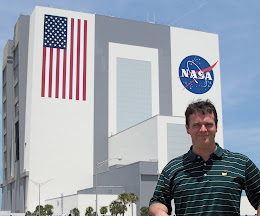A mighty European rocket will carry aloft two high definition broadcast satellites on Friday, providing direct to home television for Europe and Japan.
The European ASTRA 1N and Japan's BSAT 3C/JCSAT 110R satellites will be carried into earth orbit by the mighty Ariane 5.
The 165-foot white rocket was rolled to it's launch pad today, where it was then connected to fuel lines and power support equipment.
Fueling of the core stage with super cold liquid oxygen and liquid hydrogen fuels will begin five hours before launch.
Fueling of the core stage with super cold liquid oxygen and liquid hydrogen fuels will begin five hours before launch.
Powered by twin solid rocket boosters and a core main engine, the fifty-ninth flight of an Ariane 5 is set for 5:43:07 p.m. EDT (6:43 p.m. local) from launch complex 3 in Kourou, French Guiana.
The rocket will soar up and out over the southern Atlantic waters on a trajectory inclined 2 degrees to the equator.
The three segment, 103-foot tall boosters create 91% of the rocket's thrust during the opening minutes of the launch.
Just over two minutes into the flight, the twin boosters will have exhausted it's solid fuel and then separate ten seconds later at an altitude of 43 miles high.
Next, the cone-shaped payload cover will split in half and separate just over three minutes into the ascent.
The 55-foot tall payload fairings acts as a protective shield as the rocket's speed acts against the think atmosphere, where pressures build in a dynamic force known as MAX-Q.
The French-built ASTRA 1N broadcast satellite will ride to space in the top position of the nose fairing section, with JCSAT 110R positioned below.
The cryogenic fueled Vulcain 2 engine will keep pushing the rocket higher before shutting down nearly nine minutes after launch at a speed of 15,395 m.p.h.
The rocket will soar up and out over the southern Atlantic waters on a trajectory inclined 2 degrees to the equator.
The three segment, 103-foot tall boosters create 91% of the rocket's thrust during the opening minutes of the launch.
Just over two minutes into the flight, the twin boosters will have exhausted it's solid fuel and then separate ten seconds later at an altitude of 43 miles high.
Next, the cone-shaped payload cover will split in half and separate just over three minutes into the ascent.
The 55-foot tall payload fairings acts as a protective shield as the rocket's speed acts against the think atmosphere, where pressures build in a dynamic force known as MAX-Q.
The French-built ASTRA 1N broadcast satellite will ride to space in the top position of the nose fairing section, with JCSAT 110R positioned below.
The cryogenic fueled Vulcain 2 engine will keep pushing the rocket higher before shutting down nearly nine minutes after launch at a speed of 15,395 m.p.h.
The Ariane's upper stage takes over seconds later and will boost the duel payload into a higher elliptical orbit and at a faster orbital velocity of 22,029 m.p.h.
The 11,795-pound SES ASTRA 1N will be placed into orbit at 28.2 degrees East for a short time, and slowly moved over to it's planned operating location at 19.2 degrees East.
The twenty-one foot long satellite will operate with 52 Ku-bands transponders to support most of Europe's cable and satellite broadcasts to homes and businesses.
ASTRA will be the first to separate from the upper stage and satellite stack at 6:10 p.m. at an altitude of 615 miles.
Following the separating of ASTRA's support structure nine minutes later, the second satellite will be positioned for release by a series of thruster firings.
JCSAT 110R will then separate from the upper stage thirty-eight minutes after leaving the jungles of South America.
The twenty-one foot long satellite will operate with 52 Ku-bands transponders to support most of Europe's cable and satellite broadcasts to homes and businesses.
ASTRA will be the first to separate from the upper stage and satellite stack at 6:10 p.m. at an altitude of 615 miles.
Following the separating of ASTRA's support structure nine minutes later, the second satellite will be positioned for release by a series of thruster firings.
JCSAT 110R will then separate from the upper stage thirty-eight minutes after leaving the jungles of South America.
Built jointly by Lockheed Martin Commercial Space Systems and Sky Perfect JSAT, the 6,415-pound BSAT 3C/JCSAT 110R satellite will operate in geostationary orbit over 110-degrees East.
The duel solar array satellite measures 17 feet across and is expected to service Japan for over sixteen years with both high speed communications and cable TV service via 24 active Ku-band transponders.
This flight will mark the 203rd launch of an Ariane rocket.















